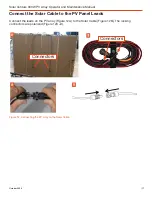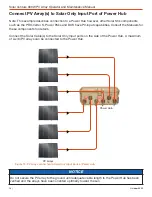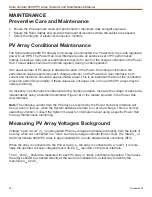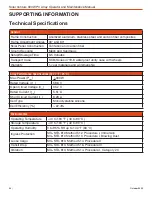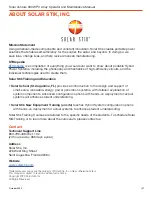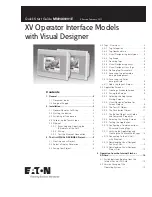
|
19
October 2020
Solar Venture 300W PV Array Operator and Maintenance Manual
PV Array Orientation for Optimum PV Power Generation
PV generation requires direct sunlight for maximum performance. Optimal PV power generation is
achieved by orienting all PV arrays in the same direction and at the same angle.
Note:
Harvesting PV energy will not improve by orienting subsets of PV arrays to capture
morning, midday, and evening sun. In the Northern Hemisphere, the PV arrays should be
positioned so that they face the noon sun, which is usually true South, true North if in the
Southern Hemisphere. The PV arrays may be deployed flat, aimed straight up if at or near the
equator.
Seasonal Adjustment of the PV Array Tilt to Improve Output
The PV array performance may be improved by adjusting the tilt and orientation of the panels
seasonally. The angle of the array, relative to the sun, can be adjusted to 30° or 60° prior to securing
to the ground. The sun is higher overhead during the summer and lower on the horizon during the
winter.
Power output of the PV arrays can be monitored in real time on the Power Hub User Interface. (See
the Power Hub Operator Manual for instructions.) Monitoring the power output while orienting and
choosing the best tilt angle for the panels will assist in finding and maintaining optimum power
output throughout the year.
Position the PV Arrays for Optimal Power Generation
NOTICE
The setup location should have good exposure to sunlight and be away from other structures or
potential hazards such as moving-vehicle thoroughfares.
Shading
The PV arrays must be positioned so they are not shaded. During periods of inclement weather or if
the array is not positioned optimally, daily power generation levels may be reduced.
Derating, Solar Loading, and Airflow
Derating occurs when the power output of the PV arrays is diminished below their rated values. PV
arrays may accumulate excessive amounts of heat due to solar loading and lack of airflow, resulting
in derating.
Locate PV arrays where airflow is unobstructed to reduce the impact of solar loading–induced
derating.













